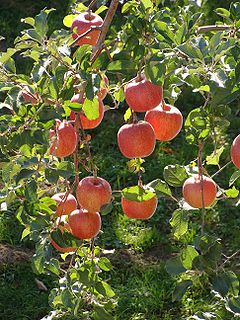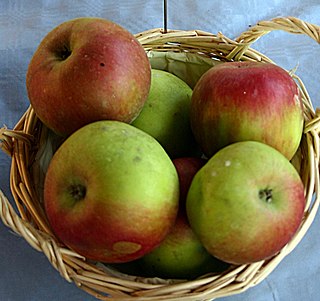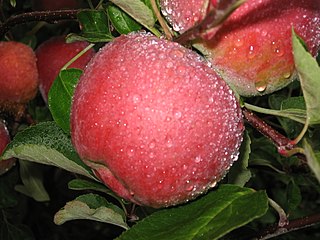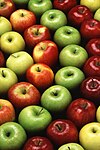
The McIntosh, McIntosh Red, or colloquially the Mac, is an apple cultivar, the national apple of Canada. The fruit has red and green skin, a tart flavour, and tender white flesh, which ripens in late September. In the 20th century it was the most popular cultivar in Eastern Canada and New England, and is considered an all-purpose apple, suitable both for cooking and eating raw. Apple Inc. employee Jef Raskin named the Macintosh line of personal computers after the fruit.

Fruit tree propagation is usually carried out vegetatively (non-sexually) by grafting or budding a desired variety onto a suitable rootstock.

'Golden Delicious' is a yellow apple, one of the 15 most popular cultivars in the United States. It is not closely related to 'Red Delicious'.

The Granny Smith is a tip-bearing apple cultivar which originated in Australia in 1868. It is named after Maria Ann Smith, who propagated the cultivar from a chance seedling. The tree is thought to be a hybrid of Malus sylvestris, the European wild apple, with the domesticated apple Malus domestica as the polleniser.

The Fuji apple is an apple cultivar developed by growers at Tohoku Research Station (農林省園芸試験場東北支場) in Fujisaki, Aomori, Japan, in the late 1930s, and brought to market in 1962. It originated as a cross between two American apple varieties—the Red Delicious and old Virginia Ralls Janet apples. According to the US Apple Association website it is one of the fifteen most popular apple cultivars in the United States. Its name is derived from the first part of the town where it was developed: Fujisaki.

An heirloom plant, heirloom variety, heritage fruit, or heirloom vegetable is an old cultivar of a plant used for food that is grown and maintained by gardeners and farmers, particularly in isolated or ethnic minority communities of the Western world. These were commonly grown during earlier periods in human history, but are not used in modern large-scale agriculture.

Cortland is a cultivar of apple developed at the New York State Agricultural Experiment Station in Geneva, New York, United States in 1898. The apple was named after nearby Cortland County, New York. It is among the fifteen most popular in the United States and Canada. Sugar 12.5%, acid 8 g/litre, vitamin C 6 mg/100g.
The New York State Agricultural Experiment Station (NYSAES) at Geneva, Ontario County, New York State, is an agricultural experiment station operated by the New York State College of Agriculture and Life Sciences at Cornell University. In August 2018, the station was rebranded as Cornell AgriTech, but its official name remains unchanged.

The Braeburn is a cultivar of apple that is firm to the touch with a red/orange vertical streaky appearance on a yellow/green background. Its color intensity varies with different growing conditions.

Jonagold is a cultivar of apple which was developed in 1953 in New York State Agricultural Experiment Station of Cornell University's College of Agriculture and Life Sciences, a cross between the crisp Golden Delicious and the blush-crimson Jonathan. They form a large sweet fruit with a thin skin. Because of their large size they are now favoured by commercial growers in many parts of the world. Jonagold is triploid, with sterile pollen, and as such, requires a second type of apple for pollen and is incapable of pollenizing other cultivars. The Jonagored Apple, a sport mutation of Jonagold, was once covered under United States Patent PP05937, now expired.

Honeycrisp is an apple cultivar developed at the Minnesota Agricultural Experiment Station's Horticultural Research Center at the University of Minnesota, Twin Cities. Designated in 1974 with the MN 1711 test designation, patented in 1988, and released in 1991, the Honeycrisp, once slated to be discarded, has rapidly become a prized commercial commodity, as its sweetness, firmness, and tartness make it an ideal apple for eating raw. "...The apple wasn't bred to grow, store or ship well. It was bred for taste: crisp, with balanced sweetness and acidity." It has larger cells than most apple cultivars, a trait which is correlated with juiciness, as theoretically a higher number of cells rupture when bitten releases more juice in the mouth. The Honeycrisp also retains its pigment well and has a relatively long shelf life when stored in cool, dry conditions. Pepin Heights Orchards delivered the first Honeycrisp apples to grocery stores in 1997. The name Honeycrisp was trademarked by the University of Minnesota, but university officials were unsure of its protection status in 2007. It is now the official state fruit of Minnesota.

Idared is a type of apple cultivar from Moscow, Idaho, United States. Variety is characterized by a non-uniform skin color.

'Macoun' apples are a cross between the 'McIntosh' and 'Jersey Black' cultivars. The Macoun was developed at the New York State Agricultural Experiment Station in Geneva, by Richard Wellington. It was first introduced in 1923, and is an eating apple. This apple is excellent for making European style apple pies because it doesn't break down during cooking and remains firm. Macouns are also very popular at roadside stands and pick-your-own farms. Availability is generally October through November. Sugar 13%, acid 6g/litre, vitamin C 4mg/100g.

Liberty is a hybrid apple cultivar developed by the New York State Agricultural Experiment Station. It was a seedling produced in 1955 from pollinating 'Macoun' from 'Purdue 54-12' for the sake of acquiring Malus floribunda disease resistances. It was first released to the public in 1978.

The 'York Imperial', or 'York', is a cultivar of apple from which a number of other valuable strains and cultivars have arisen, including four sport varieties: Commander York, Ramey York, Red Yorking, and Yorking.

Opal is the brand name for a cultivar of apple also known as 'UEB32642', produced by crossing 'Golden Delicious' with 'Topaz'. Developed by the Institute of Experimental Botany in Prague and FruitSelect in 1999, it is grown by FirstFruits Farms LLC in Washington and marketed by FirstFruits Marketing. It is also cultivated in Austria, the Netherlands, France and the United Kingdom. Opal is a variety registered with the Community Plant Variety Office of the European Union.
Albert Etter (1872–1950) was an American plant breeder best known for his work on strawberry and apple varieties.

Wijcik McIntosh is a mutation of the McIntosh apple that has a columnar growing habit, meaning that it grows straight and upright, and is spur-bearing, without any major branching. This property is very much appreciated for use as an ornamental plant for itself, and also in the breeding of other apple cultivars, to make them columnar as well.

Honeynut squash is a winter squash cultivar bred from butternut and buttercup squash. It has a similar shape and flavor to butternut squash but averages about half the size and is significantly sweeter. It has dark tan to orange skin and orange fleshy pulp. When ripe, it turns from green to a deep orange and becomes sweeter and richer. It has two to three times more beta-carotene than butternut squash. Although technically a fruit, honeynut squash is used as a vegetable that can be roasted, sautéed, puréed, added to soups, stews, and braises, and is suitably sweet for desserts.

Albert Franklin Yeager was an American horticulturalist. From his work developing hardy vegetables and fruits at the North Dakota Agricultural College (NDAC) and the North Dakota Agricultural Experiment Station (NDAES), he was known as the "plant wizard of the north" and the "Luther Burbank of North Dakota."



















